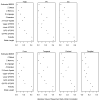Functional impact of white matter hyperintensities in cognitively normal elderly subjects
- PMID: 21060015
- PMCID: PMC3025610
- DOI: 10.1001/archneurol.2010.280
Functional impact of white matter hyperintensities in cognitively normal elderly subjects
Abstract
Objective: To investigate the impact white matter hyperintensities (WMH) detected on magnetic resonance imaging have on motor dysfunction and cognitive impairment in elderly subjects without dementia.
Design: Cross-sectional study.
Setting: Population-based study on the incidence and prevalence of cognitive impairment in Olmsted County, Minnesota.
Participants: A total of 148 elderly subjects (65 men) without dementia ranging in age from 73 to 91 years.
Main outcome measures: We measured the percentage of the total white matter volume classified as WMH in a priori-defined brain regions (ie, frontal, temporal, parietal, occipital, periventricular, or subcortical). Motor impairment was evaluated qualitatively using the Unified Parkinson's Disease Rating Scale summary measures of motor skills and quantitatively using a digitized portable walkway system. Four cognitive domains were evaluated using z scores of memory, language, executive function, and visuospatial reasoning.
Results: A higher WMH proportion in all regions except the occipital lobe was associated with lower executive function z score (P value <.01). A higher WMH proportion in all regions, but most strongly for the parietal lobe, correlated with higher Unified Parkinson's Disease Rating Scale gait, posture, and postural stability sum (P value <.01). A higher WMH proportion, whether periventricular, subcortical, or lobar, correlated with reduced velocity (P value <.001).
Conclusions: We conclude that executive function is the primary cognitive domain affected by WMH burden. The data suggest that WMH in the parietal lobe are chiefly responsible for reduced balance and postural support compared with the other 3 lobes and may alter integration of sensory information via parietal lobe dysfunction in the aging brain. Parietal white matter changes were not the predominant correlate with motor speed, lending evidence to a global involvement of neural networks in gait velocity.
Figures


References
-
- DeCarli C, Murphy DG, Tranh M, et al. The effect of white matter hyperintensity volume on brain structure, cognitive performance, and cerebral metabolism of glucose in 51 healthy adults. Neurology. 1995;45(11):2077–2084. - PubMed
-
- Burton EJ, Kenny RA, O’Brien J, et al. White matter hyperintensities are associated with impairment of memory, attention, and global cognitive performance in older stroke patients. Stroke. 2004;35(6):1270–1275. - PubMed
-
- Breteler MM, van Amerongen NM, van Swieten JC, et al. Cognitive correlates of ventricular enlargement and cerebral white matter lesions on magnetic resonance imaging. The Rotterdam Study. Stroke. 1994;25(6):1109–1115. - PubMed
-
- de Groot JC, de Leeuw FE, Oudkerk M, Hofman A, Jolles J, Breteler MM. Cerebral white matter lesions and subjective cognitive dysfunction: the Rotterdam Scan Study. Neurology. 2001;56(11):1539–1545. - PubMed

